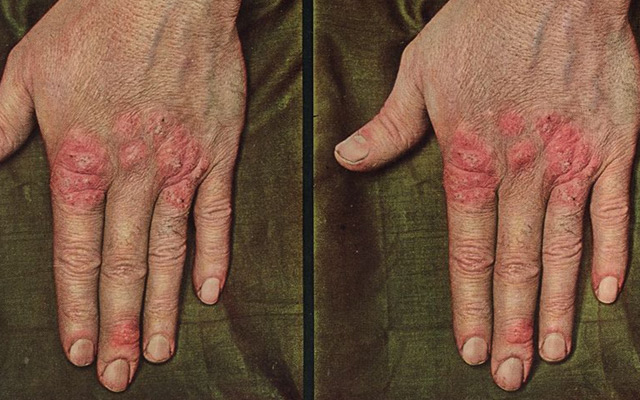Trichophytosis Capitis
- Title
- Trichophytosis Capitis
- Description
- Dermatologic stereoview card. Front of card depicts scalp of patient with an evident ringworm lesion. The reverse of the card describes the condition as well as diagnosis and treatment. Trichophytosis Capitis is described as a disease of children, practically never exhibiting in adults. It starts on the scalp as one or more roundish, scaly, and lightly raised lesions. Deterioration of the hair is evident at the ringworm site. After the disease has run its course, partial recovery can follow with some re-growth of hair. Treatment indicates that the scalp should be washed frequently to prevent further infection, and an ointment of iodin crystals mixed in goose grease to be scrubbed into the scaly patches. Trichophytosis Capitis may also be known as Tinea tonsurans, seu tondens, seu trichophytina capitis, Trichonosis furfuracea, Herpes tonsurans, seu circinatus, seu squamosus, Porrigo furfurans, or Ringworm of the scalp.
- Date
- 1910
- Original Format
- stereographs
- Extent
- Local Identifier
- LL02.49.00.114
- Creator(s)
- Subject(s)
- Spatial
- Location of Original
- Laupus Library History Collections
- Rights
-
This item has been made available for use in research, teaching, and private study. Researchers are responsible for using these materials in accordance with Title 17 of the United States Code and any other applicable statutes. If you are the creator or copyright holder of this item and would like it removed, please contact us at als_digitalcollections@ecu.edu.
http://rightsstatements.org/vocab/InC-EDU/1.0/ - Permalink
- https://digital.lib.ecu.edu/21220
- Preferred Citation
- Cite this item
- This item
-
 Trichophytosis Capitis
Trichophytosis Capitis
- My Collections Login
- Printable Feedback Form
- Found in theme/project
-
 Laupus Health Sciences History Collections
Laupus Health Sciences History Collections
-
 Health and Medicine
Health and Medicine
-
 Stereoscopic Skin Clinic
Stereoscopic Skin Clinic
- Location of Original
- Stereoscopic Skin Clinic Cards from the Laupus Library History Collections
- View all digitized items from the Stereoscopic Skin Clinic Cards
Related Search Results
Public access is provided to these resources to preserve the historical record. The content represents the opinions and actions of their creators and the culture in which they were produced. Therefore, some materials may contain language and imagery that is outdated, offensive and/or harmful. The content does not reflect the opinions, values, or beliefs of ECU Libraries.
Contact Digital Collections
If you know something about this item or would like to request additional information, click here.
Comment on This Item
Complete the fields below to post a public comment about the material featured on this page. The email address you submit will not be displayed and would only be used to contact you with additional comments or questions.


